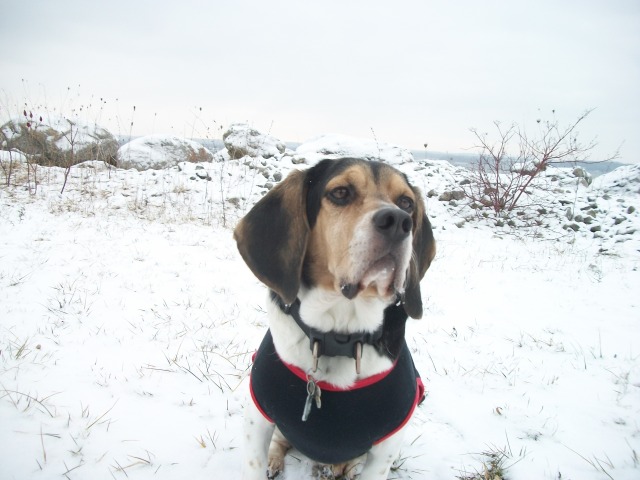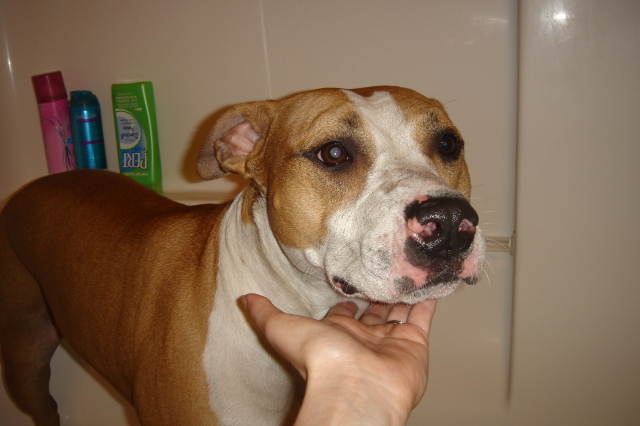QuestionHi.
My wife and I have recently gotten a 1.5 year old small black lab mix from the county animal control shelter. She behaves perfectly inside, sleeps in her crate with the door open, plays only with her toys, and is not only housebroken, but grass-trained. We feel very lucky to have found such a well-trained dog.
The problem is that her good behavior goes completely out-the-window on walks. She pulls incessantly on the leash, so much so that her front paws dangle sometimes as she pushes along with her back feet. She barks at other people sometimes, and especially at other dogs and loud trucks. She tries to chase cars as well. We live in an urban environment, so these behaviors are a real nuisance to other people on the sidewalks, and it is embarrassing how little control we have over her outside.
We have tried a choke chain, but are uncomfortable continuing with it for safety reasons since she doesn't seem to mind not being able to breathe. We recently bought a Kumalong Headcollar, and tried to assimilate her to the collar slowly inside. She doesn't seem to mind it inside, but she freaks out as soon as she is outside and tries valiantly to wiggle out of it. This is even more embarrassing than her previous bad behavior.
We've also tried positive reinforcement in the form of treats, but she is too easily distracted and still misbehaves whenever a dog, truck, or person comes along. I don't think she is associating the treat with good behavior, because she as soon as she gulps it down she's barking again.
I have had some experience in behaviorism, and I know that training takes time and repetition, but she is testing our patience. We want walks to be positive experiences for both us and her.
AnswerI am not familiar with the Kumalong brand of head collars, but other brands such as Gentle Leader work very well, with most dogs adjusting to them right away. Try working with her in your own back yard for a while and see if she adjusts.
You might look at the slip collar too. It has a long history of safe, effective use. I will not deny there have been neck injuries with them. However it takes a violent, abusive jerk on one to injure a dog over 5 months with one unless it was it had very small links. Put it on like this for the
usual dog on the left position. Pull the chain through the one ring forming a
"P". Facing the dog, slip it over its head. The free end comes over the neck
allowing the other end to release pressure when the leash is slack. Although you can do the flip the dog over corrections with one, there are other techniques easier on both the dog and the trainers arm. But
you don't want to use any more force than you need. One gentle technique I
like is to just stop when he pulls. He wants to go. If you move forward when
the leash is slack, and stop when he pulls, he should quickly figure out the
only way to get to go, is not to pull. This is about teaching him not to
pull, not getting somewhere. The man that taught it to me said "If in a half
hour you haven't made it out to the front walk, fine, you have taught him a lesson. Another technique is to reverse direction leaving the dog to catch up before it can start pulling. then again reverse directions.
The last option is the prong collar. It is absolutely essential to have somebody that really know what they are doing fit it. Too loose, and it is useless. To tight, and you can kill the dog. Different dogs respond to different collars. I only mention it because it may be what works for you. Before trying one, find somebody god to fit it.

 Dachshund spay - swollen mammaries
Question
Lilly
Hi Patti,
We took our 10 month old mini
Dachshund spay - swollen mammaries
Question
Lilly
Hi Patti,
We took our 10 month old mini
 Temperature before birth
QuestionQUESTION: My female cheweenie is on day 52 of h
Temperature before birth
QuestionQUESTION: My female cheweenie is on day 52 of h
 2nd Dog
Question
Winston
Hi, I have a beagle/bassest hou
2nd Dog
Question
Winston
Hi, I have a beagle/bassest hou
 Dog breed?
QuestionQUESTION: Hi Nancy,
I am attaching an image of
Dog breed?
QuestionQUESTION: Hi Nancy,
I am attaching an image of
 what is my dog????
Question
Connie
Patti, i got my dog Connie a few months
what is my dog????
Question
Connie
Patti, i got my dog Connie a few months